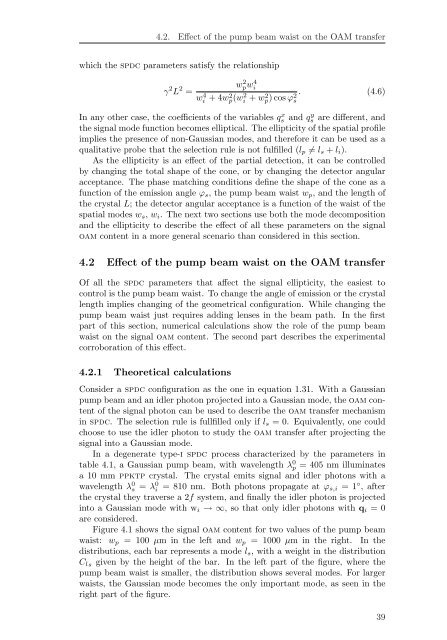Spatial Characterization Of Two-Photon States - GAP-Optique
Spatial Characterization Of Two-Photon States - GAP-Optique
Spatial Characterization Of Two-Photon States - GAP-Optique
You also want an ePaper? Increase the reach of your titles
YUMPU automatically turns print PDFs into web optimized ePapers that Google loves.
4.2. Effect of the pump beam waist on the OAM transfer<br />
which the spdc parameters satisfy the relationship<br />
γ 2 L 2 w<br />
=<br />
2 pw4 i<br />
w4 i + 4w2 p(w2 i + w2 p) cos ϕ2 s<br />
. (4.6)<br />
In any other case, the coefficients of the variables q x s and q y s are different, and<br />
the signal mode function becomes elliptical. The ellipticity of the spatial profile<br />
implies the presence of non-Gaussian modes, and therefore it can be used as a<br />
qualitative probe that the selection rule is not fulfilled (lp = ls + li).<br />
As the ellipticity is an effect of the partial detection, it can be controlled<br />
by changing the total shape of the cone, or by changing the detector angular<br />
acceptance. The phase matching conditions define the shape of the cone as a<br />
function of the emission angle ϕs, the pump beam waist wp, and the length of<br />
the crystal L; the detector angular acceptance is a function of the waist of the<br />
spatial modes ws, wi. The next two sections use both the mode decomposition<br />
and the ellipticity to describe the effect of all these parameters on the signal<br />
oam content in a more general scenario than considered in this section.<br />
4.2 Effect of the pump beam waist on the OAM transfer<br />
<strong>Of</strong> all the spdc parameters that affect the signal ellipticity, the easiest to<br />
control is the pump beam waist. To change the angle of emission or the crystal<br />
length implies changing of the geometrical configuration. While changing the<br />
pump beam waist just requires adding lenses in the beam path. In the first<br />
part of this section, numerical calculations show the role of the pump beam<br />
waist on the signal oam content. The second part describes the experimental<br />
corroboration of this effect.<br />
4.2.1 Theoretical calculations<br />
Consider a spdc configuration as the one in equation 1.31. With a Gaussian<br />
pump beam and an idler photon projected into a Gaussian mode, the oam content<br />
of the signal photon can be used to describe the oam transfer mechanism<br />
in spdc. The selection rule is fullfilled only if ls = 0. Equivalently, one could<br />
choose to use the idler photon to study the oam transfer after projecting the<br />
signal into a Gaussian mode.<br />
In a degenerate type-i spdc process characterized by the parameters in<br />
table 4.1, a Gaussian pump beam, with wavelength λ 0 p = 405 nm illuminates<br />
a 10 mm ppktp crystal. The crystal emits signal and idler photons with a<br />
wavelength λ 0 s = λ 0 i = 810 nm. Both photons propagate at ϕs,i = 1 ◦ , after<br />
the crystal they traverse a 2f system, and finally the idler photon is projected<br />
into a Gaussian mode with wi → ∞, so that only idler photons with qi = 0<br />
are considered.<br />
Figure 4.1 shows the signal oam content for two values of the pump beam<br />
waist: wp = 100 µm in the left and wp = 1000 µm in the right. In the<br />
distributions, each bar represents a mode ls, with a weight in the distribution<br />
Cls given by the height of the bar. In the left part of the figure, where the<br />
pump beam waist is smaller, the distribution shows several modes. For larger<br />
waists, the Gaussian mode becomes the only important mode, as seen in the<br />
right part of the figure.<br />
39



